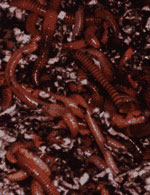The problem with winter is that nothing rots.
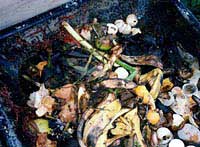
Yummy! — compost in action.
Photo: Texas A&M Dept. of Horticultural
Sciences and Aggie Horticulture.
This won’t bother you if you don’t have a compost pile, but if you do, you are frozen on the horns of a messy dilemma. The wondrous microbial engine of your compost pile is no match for the big chill of winter. The tiny ecosystem that magically changed coffee grounds and sandwich crusts into prize-winning geraniums is chased underground until spring.
If you still insist upon leaving your warm kitchen during the winter months for gelid treks to your dormant compost pile to conscientiously dispose of potato peels and Aunt Bee’s fruitcake, you can count on three things: a) your bin will quickly fill with bizarre frozen constellations of broccoli stalks and green beans worthy of Jackson Pollack that b) will transform themselves into a sloppy, gelatinous mess come spring that c) may provoke unwelcome scrutiny from delicate neighbors, the city’s health department, and other assorted vermin.
Faced with this dilemma, many people stop composting for the season, abandoning their organic wastes to city sanitation or the local sewer district. But this increases the cost of city services and deprives the earth of valuable nutrients that could easily be reclaimed. It also robs you of a no-fail conversation starter for your company holiday party: “I have pet worms.”
My worms have always lived in a composting box in the basement. Whenever the kitchen compost bucket overflows, I trudge downstairs with the slops. It’s kind of like keeping pigs, but worms don’t smell, they don’t grunt or squeal, and their manure is the plant food of the gods, the queen of compost, shit extraordinaire.
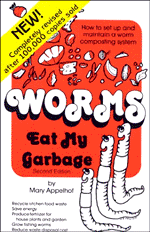
Okay, you’re not convinced. Normally people with worms in their basement call their exterminator, perhaps even their realtor. But this really works. Mary Applehoff’s excellent guide to vermicomposting, Worms Eat My Garbage, even pictures a cleverly designed kitchen worm bin topped by a cutting board. (If you get really hard core, I’d suggest a companion volume, the juvenile fiction classic How to Eat Fried Worms, featuring such cuisine as the Whizband Worm Delight.)
You can keep your worms just about anywhere in your home, but you may want to consult with housemates first. Jerry Minnich, author of the 1977 opus The Earthworm Book, recalls a desperate letter he received from a woman while he was on the staff of Organic Gardening. “Her husband was composting earthworms under their bed,” he says. “She was wondering if this was grounds for divorce.” After exhausting the potential for intra-office humor, “we wrote back to her saying that this was a personal manner, but that if everything was contained within the bin we didn’t see any problem.”
Global Worming
Granted, worms lack for sex appeal in this day and age. But it was not always thus. While there is as yet no hieroglyphic or archeological evidence that Cleopatra kept a worm bin under her bed, she did declare the little crawlers to be sacred and forbade their harvest or harm — all without apparent repercussions to her love life.

Chuck D. and a worm buddy.
Charles Darwin, too, when not toppling paradigms, spoke highly of the earthworm. Shortly before his death, he followed up The Origin of Species and The Descent of Man with The Formation of Vegetable Mould through the Action of Worms with Observations on their Habits. “It may be doubted whether there are many other animals which have played so important a part in the history of the world as have these lowly organized creatures,” he concluded.
Minnich concurs, writing in The Earthworm Book: “The earthworm has played a paramount role in the building of man’s great civilizations. Were it not for this creature, in fact, it is entirely possible that man would still be subsisting in a primitive, semiprimitive, or squalid state, devoting most of his energies to growing or gathering food and fighting off attackers.”
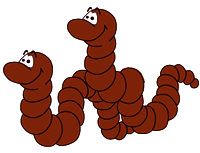
As evidence, Minnich cites scholarship linking the rise of great agricultural societies in the Fertile Crescent to prolific soil-working earthworms. Similarly, agricultural productivity on the Atlantic Coast of the United States and elsewhere gained immeasurably from the earthworms the colonists unwittingly brought with them. In other words, thank the lowly earthworm not only for organic asparagus, but for Napster, the Denver Broncos, and nuclear arsenals.
Of course, in this day of ecological sensibilities, the work of worms is not universally acclaimed. It seems most resident American worms are invasive species, exotics that have supplanted native species, and scientists are beginning to learn that they may as yet cause great harm to some native ecosystems. In all likelihood, your neighborhood was colonized long ago, so stamping out exotic worms is about as fruitless as a crusade against dandelions. Still, so as not to exacerbate the problem, you should probably reconsider any overzealous plans to bring your worms along on backpacking trips in the Canadian Rockies. (In this sense worms are ideal pets for the commitment-challenged. They can go without food for months while you travel the world ’round.)
How to Feed the Beasts
A messianic passion for worms is not a requirement for vermicomposting. In fact, to get started you only need four things: a sense of how much kitchen waste you generate in an average week, a worm bin, bedding for your worms, and — of course — the squirmers themselves.
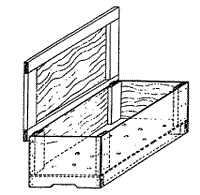
An example bin.
Diagram: Seattle Tilth.
You can feed worms most anything except meat or bones, and not too much cheese, butter, or oil. For every pound of food waste you create per week, you’ll need one square foot of bin space. Worms are surface feeders, so don’t make your bin deeper than one foot. You can use a plastic tub or construct a bin out of scrap wood or plywood. Drill quarter-inch holes every six inches around the bottom and sides to allow ventilation and drainage.
You’ll need biodegradable bedding that can hold a lot of moisture but also allow the passage of air so odors don’t develop. You can use leaves, peat moss, straw, or shredded newspaper or corrugated cardboard. Add a couple of handfuls of soil to jumpstart bacterial breakdown and provide grit for the worms’ digestive tracts.
I use leaves because they are free and easily available, but they can mat down, making it harder to bury your food waste. (With leaves, you also import other critters, such as potato bugs, springtails, and centipedes. By and large, these help with composting, but can be annoying.) Peat costs money, and can be a little acidic for worms (crushed eggshells can ease this). Straw breaks down slowly, and is also hard to moisten. Shredded paper and cardboard are
probably more valuable to your local recycler than to the worms, but if you do use paper, keep it moist. (Note to the paranoid: A worm bin can be the perfect complement to your paper shredder. No forensic expert in the world can glean your credit card number from worm droppings.) And remember to avoid using paper printed with color inks because they can contain heavy metals, which aren’t good for your worms or your garden.
Once you have moistened the bedding, it’s ready for worms. Garden variety (ahem) earthworms won’t thrive in these conditions, and may even try to escape. Red wigglers (Eisenia foetida), also known as red worms or manure worms, are ideal, as they can practically eat their weight in a single day, and they breed prolifically. They can be ordered by mail, procured from local bait shops, or dug out of manure piles.
Feed your worms when you like, but the more regularly, the better. Smaller chunks of food break down faster. Think of the bin as a tic-tac-toe board, and fill in one square at a time, using all the squares before starting over again. Scraps left on the surface might encourage fruit flies, but don’t bury them too deep. A piece of black plastic on top will keep light out and moisture in.
After three or four months, your bin will contain a rich, dark soil. If it’s spring and you don’t intend to vermicompost again until fall, you can dump the bin on your garden or spread it over your lawn as fertilizer. If you want to keep your worms, a bright light will drive them to the bottom of the bin, so you can skim off the compost. Or you can push the compost to one side of the bin and fill the other half with fresh bedding and new garbage, and the worms will migrate.
Once you get started, the worms do the work. If you give them food and shelter, Aristotle’s “intestines of the earth” will enrich your own corner of the planet.
